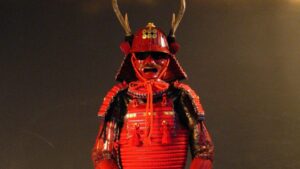Ichijo-dani Asakura Clan Ruins
Nestled in the quiet mountains of eastern Fukui Prefecture lies Ichijo-dani. This castle town served as the political and cultural center of the Asakura clan, who ruled the Echizen Province (present-day Fukui Prefecture) for five generations over a span of 103 years during the Warring States period. Asakura Sōteki (1477–1555, 朝倉宗滴), a wise and strategic commander who led the Asakura clan to its zenith, and his grandson Asakura Yoshikage (1533–1573, 朝倉義景), who upheld ideals of peace and culture even amidst the turbulence of war. Though the Asakura clan ultimately fell before Oda Nobunaga, the Ichijo-dani valley still preserves a quiet dignity and beauty—an enduring echo of a refined age long past. At the heart of the former Asakura residence stands the karahafu-style front gate, which continues to welcome visitors today.
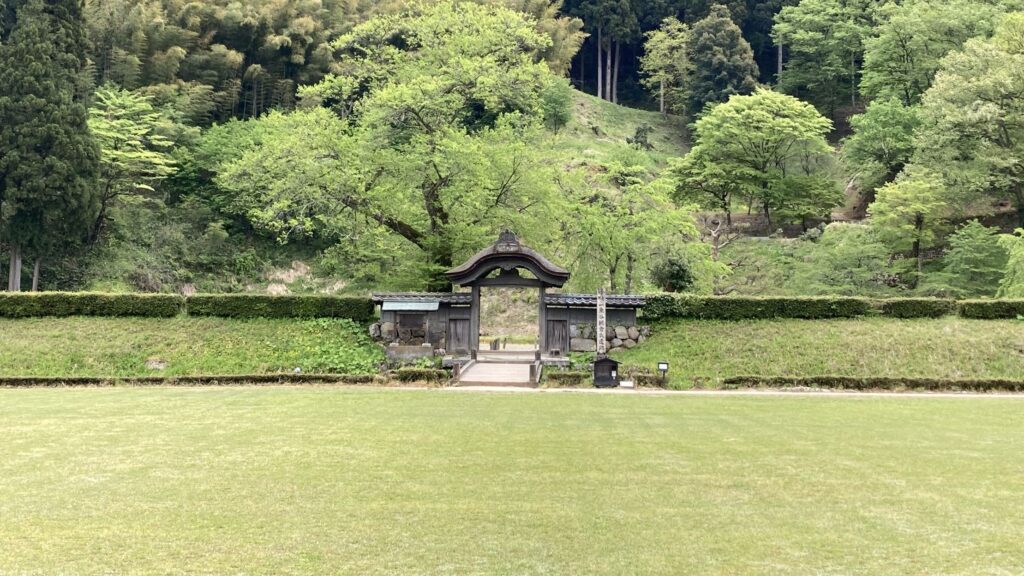
Little Kyoto in Hokuriku
Even amid an age dominated by warfare, the Asakura clan actively embraced culture and refinement. They cultivated the arts of Noh theater, the tea ceremony, and kōdō (the art of incense), preserving the spirit of elegance and courtly grace, once celebrated as the Little Kyoto of Hokuriku. Throughout its history, the Asakura clan had invited numerous artists and scholars from Kyoto, fostering the flourishing of waka poetry, linked verse, tea ceremony, and other refined arts. Scattered across the valley are four exquisite historic gardens, regarded as one of Japan’s three great samurai gardens, alongside the Kitabatake Garden in Mie and the former Shūrinji Temple Garden in Shiga.
Sōteki Brought the Asakura Clan to The Height of Its Power
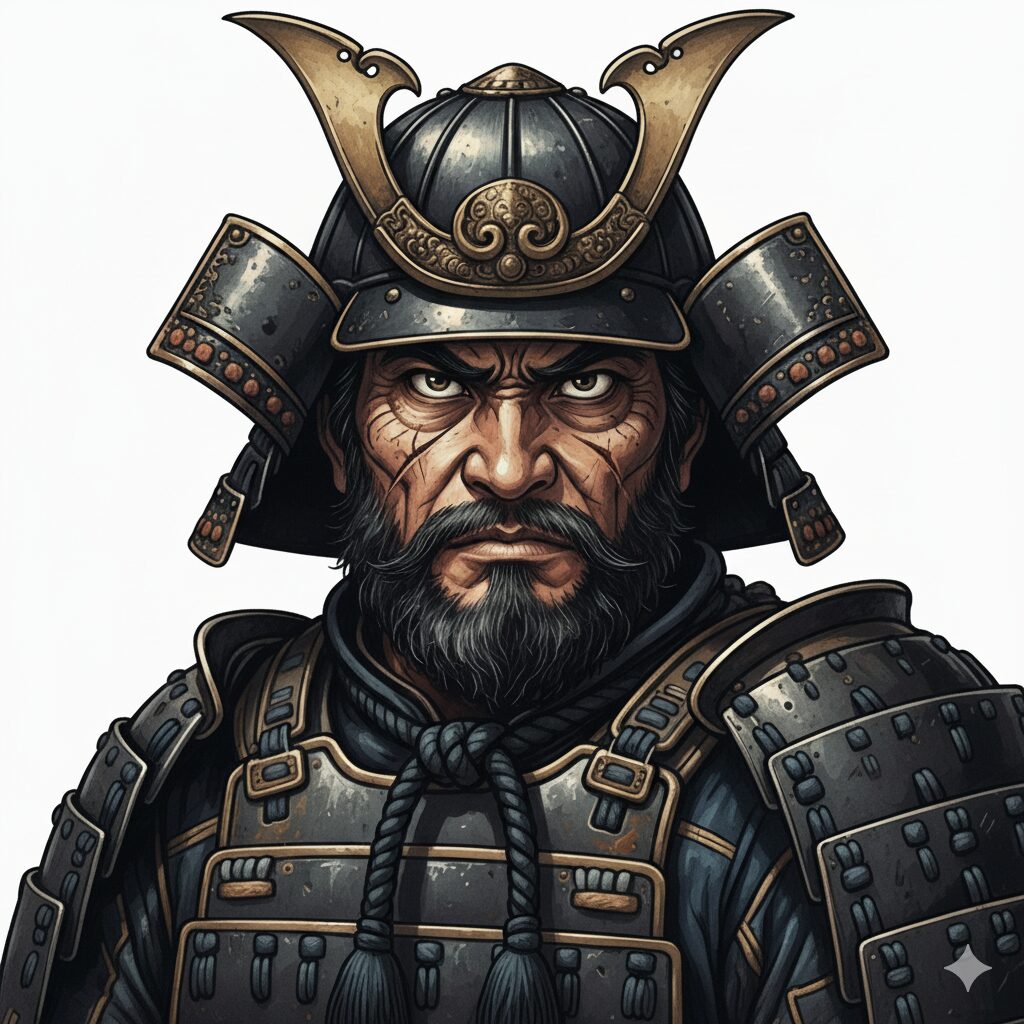
Asakura Sōteki was born as the eighth son of Asakura Takakage, the seventh head of the Asakura clan, who had risen to power in Echizen Province through the upheavals of Japan’s age of gekokujo (the era when lower-ranking samurai overthrew their superiors). Sōteki is remembered as a brilliant commander who led the Asakura army to numerous victories, bringing the clan to the height of its power. In July 1506 (Eishō 3), a massive force of approximately 300,000 followers of the Jōdo Shinshū sect of Buddhism, known as the Ikkō-ikki sect, invaded Echizen from neighboring Kaga Province. The 9th lord of the Asakura clan, Asakura Sadakage, declared it “the greatest danger to our house” and appointed Sōteki as the supreme commander. Then thirty years old, Sōteki established his headquarters at Nakagō on the Kuzuryū River, commanding a force of more than 11,000 mounted warriors. The opposing sides fought fierce engagements across the river, with neither gaining the upper hand. Soon, however, a vast reinforcement of some 108,000 Ikkō followers, led by the monk-general Wada-bō of Hongakuji Temple, joined the battle, placing the Asakura army in dire peril. In response, Sōteki divided about 3,000 of his troops into two units and ordered a surprise river crossing. The sudden counterattack caught the Ikkō forces off guard, sending them into complete rout. Riding on this momentum, the Asakura army destroyed key Ikkō strongholds, including Yoshizaki Gobo and Hongakuji, securing a decisive victory in what became known as the Battle of the Kuzuryū River.
In the years that followed, Sōteki led campaigns across Wakasa, Mino (present-day Gifu prefecture), and even Kyoto, continuing to command with remarkable skill. Under his military governance, Echizen enjoyed long stability, and the Asakura clan entered its golden age. However, in July 1555 (Tenbun 24), while marching to assist Nagao Kagetora (later known as Uesugi Kenshin) against the Ikkō uprisings in Kaga, Sōteki fell ill in camp and was forced to return home. Despite devoted care, he passed away that September at the age of seventy-nine.
Key Learning from Sōteki as a Warrior
Sōteki’s extensive battlefield experience was later compiled into a treatise known as the Tales of Asakura Sōteki, which contains eighty-three precepts on the conduct of a warrior. For example,
“A general may be called a dog or even a cat—what matters is victory above all.”
Another passage records his words:
“I spent the night pondering strategies to seize the realm and bring Lord Yoshikage to the capital, Kyoto.”
These lines reveal Sōteki’s enduring aspiration to elevate the Asakura clan to national prominence and his conviction that intellect and resolve, not lineage alone, were the true foundations of leadership.
Yoshikage's Turning Point to Confront Oda Nobunaga
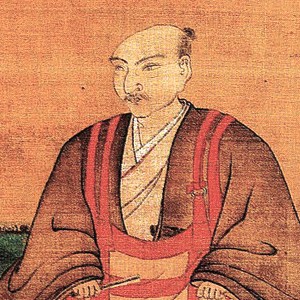
Asakura Yoshikage succeeded his father, Asakura Takakage, as the 11th head of the Asakura clan in 1548 (Tenmon 17) at the age of sixteen. At the time, the Asakura domain enjoyed long-lasting peace under the military leadership of Sōteki. However, after Sōteki’s death, it became increasingly difficult for the Asakura to resist the tide of war that swept through the Warring States period.
The turning point came in 1565 (Eiroku 8) with a shocking event—the assassination of the 13th shogun of the Muromachi shogunate, Ashikaga Yoshiteru (1536-1565, 足利義輝), by retainers of the Miyoshi clan. Yoshiteru’s younger brother, Kakukei, later known as the 15th shogun, Ashikaga Yoshiaki (1537-1597, 足利義昭), fled Kyoto and sought refuge with Asakura Yoshikage. Yoshikage received him with great courtesy and protection, but before long Yoshiaki turned to Oda Nobunaga (1534-1582, 織田信長) for support, marched to Kyoto, and took the throne of shogun. Nobunaga built Nijo Gosho as Yoshiaki's residence in Kyoto. When Nobunaga urged Yoshikage to accompany him to Kyoto, Yoshikage refused, unwilling to become subordinate to Nobunaga’s expanding power. This decision irreversibly strained their relationship, and in April 1570 (Genki 1), Nobunaga launched an invasion of the Asakura domain.
Yoshikage's Golden Opportunity to Defeat Nobunaga
As Nobunaga’s forces advanced northward along the Hokuriku route, capturing Asakura fortresses one after another, they were about to cross the strategic Kinome Pass en route to Ichijo-dani, the Asakura stronghold. At that critical moment, Azai Nagamasa, lord of Odani Castle and Nobunaga’s ally, betrayed him and struck from the rear. Near Kanegasaki Castle, with the Asakura army charging forward in front and the Azai army attacking from behind, Yoshikage was presented with a golden opportunity to crush Nobunaga. Yet Nobunaga swiftly organized a retreat, leaving Toyotomi Hideyoshi (1537-1598, 豊臣秀吉) and Tokugawa Ieyasu (1543-1616, 徳川家康) to cover his withdrawal to Kyoto. Though pursuit might have brought decisive victory, Yoshikage—citing unrest at his base in Ichijo-dani—chose not to follow, allowing Nobunaga the time he needed to regroup.
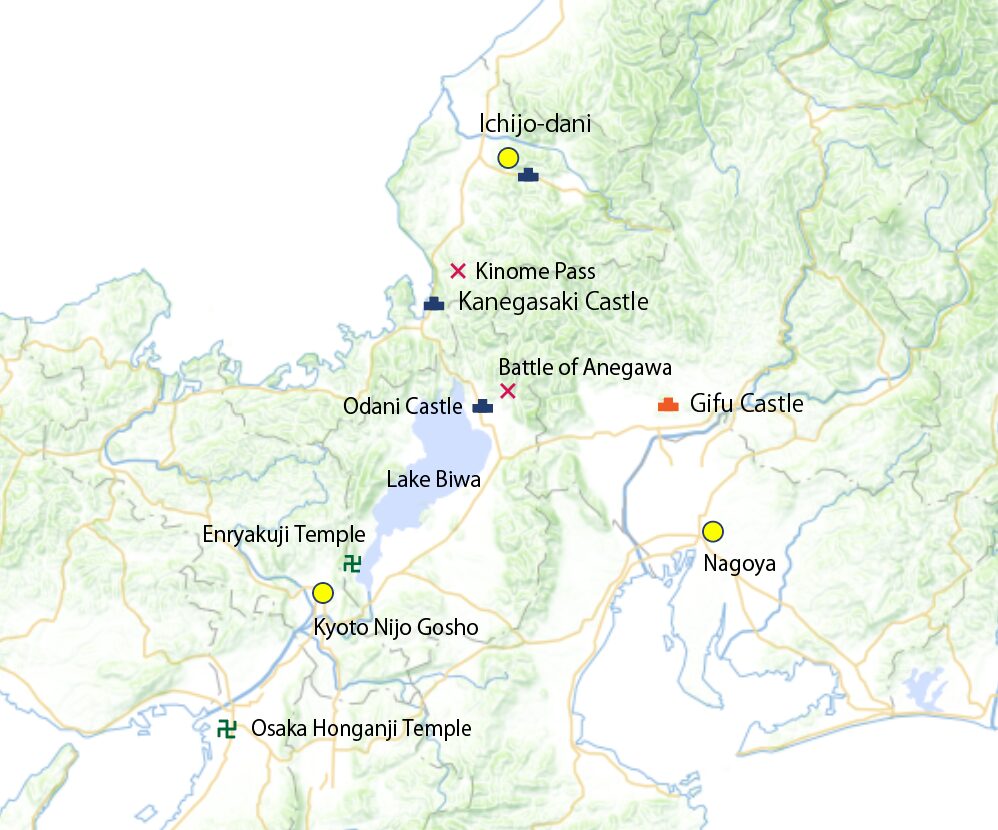
The End of the Asakura Clan’s Century-long Rule over Echizen
Nobunaga soon reorganized his forces and, together with Tokugawa Ieyasu, launched a counteroffensive. In 1570, the two sides faced each other across the Anegawa River. Yoshikage did not take the field himself but sent his retainer, Asakura Kagetake, as commander. However, the Asakura forces were broken under the fierce assault of the Tokugawa army and forced to retreat. A temporary truce followed, but the Asakura clan’s power steadily waned. Seizing the opportunity when Nobunaga dispatched his forces against the Osaka Honganji, Asakura Yoshikage advanced toward Kyoto.
When Nobunaga hastily returned, Yoshikage and the Asakura army attempted to resist by taking refuge on Mount Hiei within Enryaku-ji Temple. However, Nobunaga launched the notorious burning of Mount Hiei, and the devastation dealt a severe blow to Yoshikage’s remaining power, leaving his influence steadily diminished. Lacking military experience and advisers of Sōteki’s caliber, Yoshikage made a series of fatal misjudgments and ultimately fell before Nobunaga, who pursued his vision of national unification under the banner of Tenka Fubu (rule the realm by force of arms).
Finally, in 1573 (Tenshō 1), Nobunaga launched a full-scale attack on Ichijo-dani. The Asakura army was annihilated, and Yoshikage took his own life. The castle town burned for three days and nights, bringing to an end the Asakura family’s century-long rule over Echizen. Even today, the gardens of Ichijōdani preserve the elegance of that bygone age.
Reconstructed Ichijo-dani Castle Town
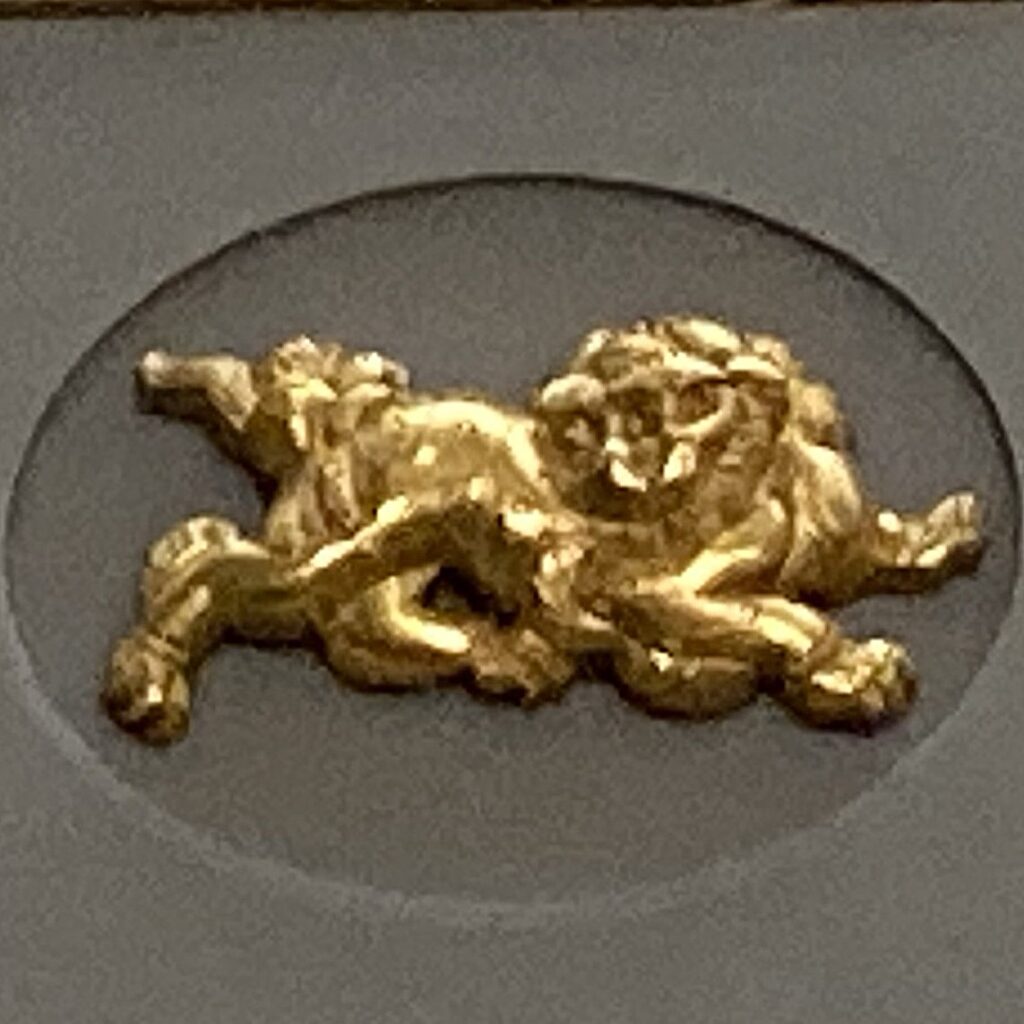
The Asakura residence site has been faithfully reconstructed, complete with a Noh stage and flower gardens, testifying to the refined tastes of the clan. Among the excavated artifacts are a golden lion-shaped menuki (sword hilt), exquisite tea utensils, glass beads, and celadon ceramics—treasures that speak to the high cultural level of the period.
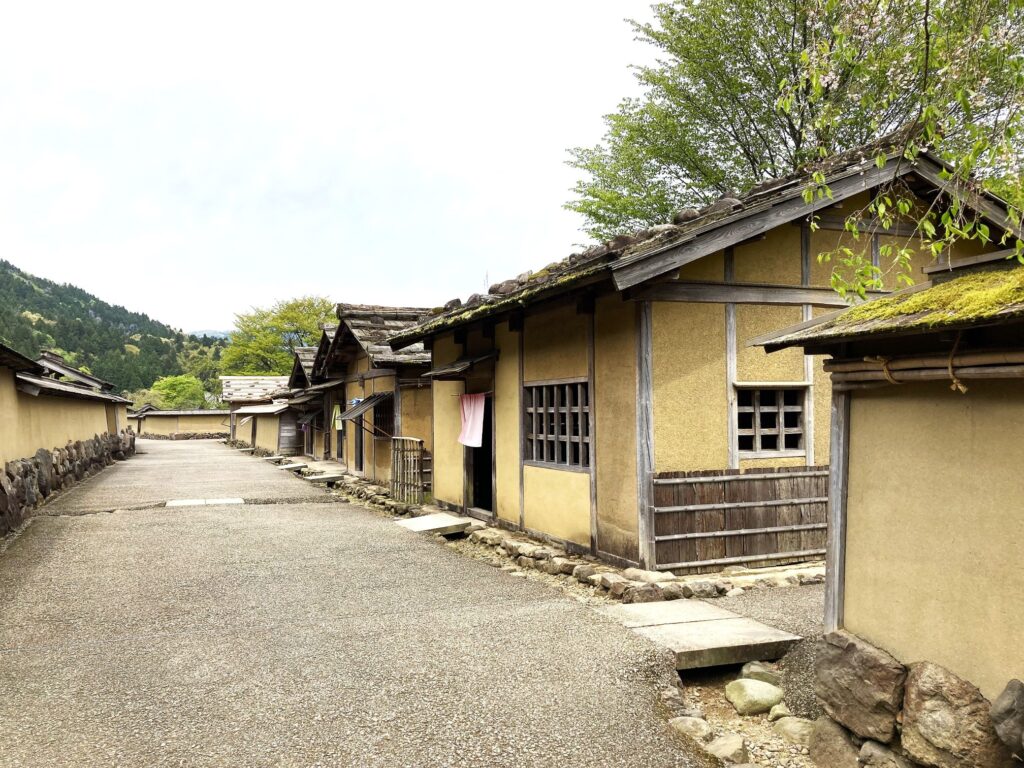
Visitors walking through the 200-meter-long restored townscape, lined with samurai residences and merchant houses, can sense the elegance and sophistication of the Asakura era and imagine the days when Ichijo-dani flourished as a cultural hub amidst the turmoil of the Sengoku era.
Asakura's Timeline
| 1477 | Birth of Asakura Sōteki | ||
| 1506 | Sōteki defeated the Ikkō-ikki at the Battle of Kuzuryūgawa | ||
| 1517 | Sōteki defeated the Wakasa Lord | ||
| 1533 | Birth of Asakura Yoshikage | ||
| 1555 | Death of Asakura Sōteki | ||
| 1568 | Ashikaga Yoshiaki took refuge in Ichijōdani | ||
| 1568 | Yoshiaki left Ichijōdani for Kyoto with Oda Nobunaga | ||
| 1570 | Battle of Anegawa | ||
| 1571 | Siege of Mount Hiei (Enryaku-ji) | ||
| 1573 | Death of Asakura Yoshikage |
Recommendations to Visit
Ichijodani Asakura Clan Ruins and Museum
- Access: Access: 15 minutes from JR Fukui Station on the Etsumi-Hokuriku Line. Get off at Ichijyodani Station. 3 minutes walk.

